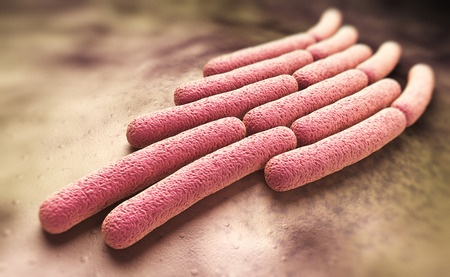
Shigella is an enteric bacterial pathogen which is the principal cause of dysentery in people with varying degrees of unpleasantness and severity. Dysentery is an acute disease of the intestine which is characterised by diarrhoea, stomach cramps, fever and usually vomiting. The stools contains mucus, pus and sometimes blood. The level of fatalities is about 1% and severity depends on the species involved. It is often seen in children and parents who care for sick children then go onto develop the disease.
We know of at least 4 species in the genus and these are Sh. dysenteriae, Sh. sonnei, Sh. boydii, and Sh. flexneri. Of the four species, Sh. dysenteriae causes the most severe symptoms whilst Sh. sonnei produces the mildest illness (Adams and Moss, 2008). Globally, it is estimated that 145 million cases of shigellosis occur annually and the victims are mainly children (Villalobo, 2011). In the United States, about half a million cases of shigellosis are reported annually, making it the third most common causative agent of bacterial enteric diseases (Scallan et al., 2011).
Shigella spp. are typically mesophilic bacteria that grow in the range of 10 to 48 °C. Shigella exhibits good growth in the pH range of 6 to 8, but cannot survive at pH < 4.5 (Zaika et al., 1989). Shigella spp. are virulent in general with low infectious dose of only 10 cells needed to initiate the disease in susceptible individuals (Crockett et al., 1996). Among the 4 Shigella spp., Sh. sonnei followed by Sh. flexneri were the most frequently isolated from different incidences of shigellosis outbreaks. The major symptoms of shigellosis are abdominal pain, vomiting, fever, and diarrhea (Villalobo, 2011).
A number of cases are reported. In December 2001, Japan banned oysters from South Korea after 159 people became ill with dysentery as the organisms was isolated from this shellfish.
Apart from good hygiene and personal practice, some organic acids which drop the pH are known to work against Shigella species (Zaika et al., 2002). Many food businesses will exclude food handlers who have contacts suffering from the disease. Indeed, practices similar to dealing with typhoid outbreaks are followed when dealing with dysentery.
References
Adams, M.R., Moss, M.O. (2008) Food Microbiology. 3rd ed. UK: Royal Society of Chemistry.
Scallan, E., Hoekstra, R.M., Angulo, F.J., Tauxe, R.V., Widdowson, M.A., Roy, S.L., Jones, J.L., Griffin, P.M. (2011) Foodborne illness acquired in the United States—major pathogens. Emerg. Infect. Diseases 17 pp. 7–15.
Villalobo, E. (2011) Pathogens in milk: Shigella spp. In: Fuquay, J.W., Fox, P.F., McSweeney, P.L.H., editors. Encyclopedia of Dairy Sciences. 2nd ed. London: Academic Press. pp. 99–103
Zaika, L.L. (2002) Effect of organic acids and temperature on survival of Shigella flexneri in broth at pH 4. J. Food Prot. 65 pp. 1417–21
Zaika, L.L., Engel, L.S., Kim, A.H., Palumbo, S.A. (1989) Effect of sodium chloride, pH and temperature on growth of Shigella flexneri. J. Food Prot. 52 pp. 356–9.
Leave a Reply